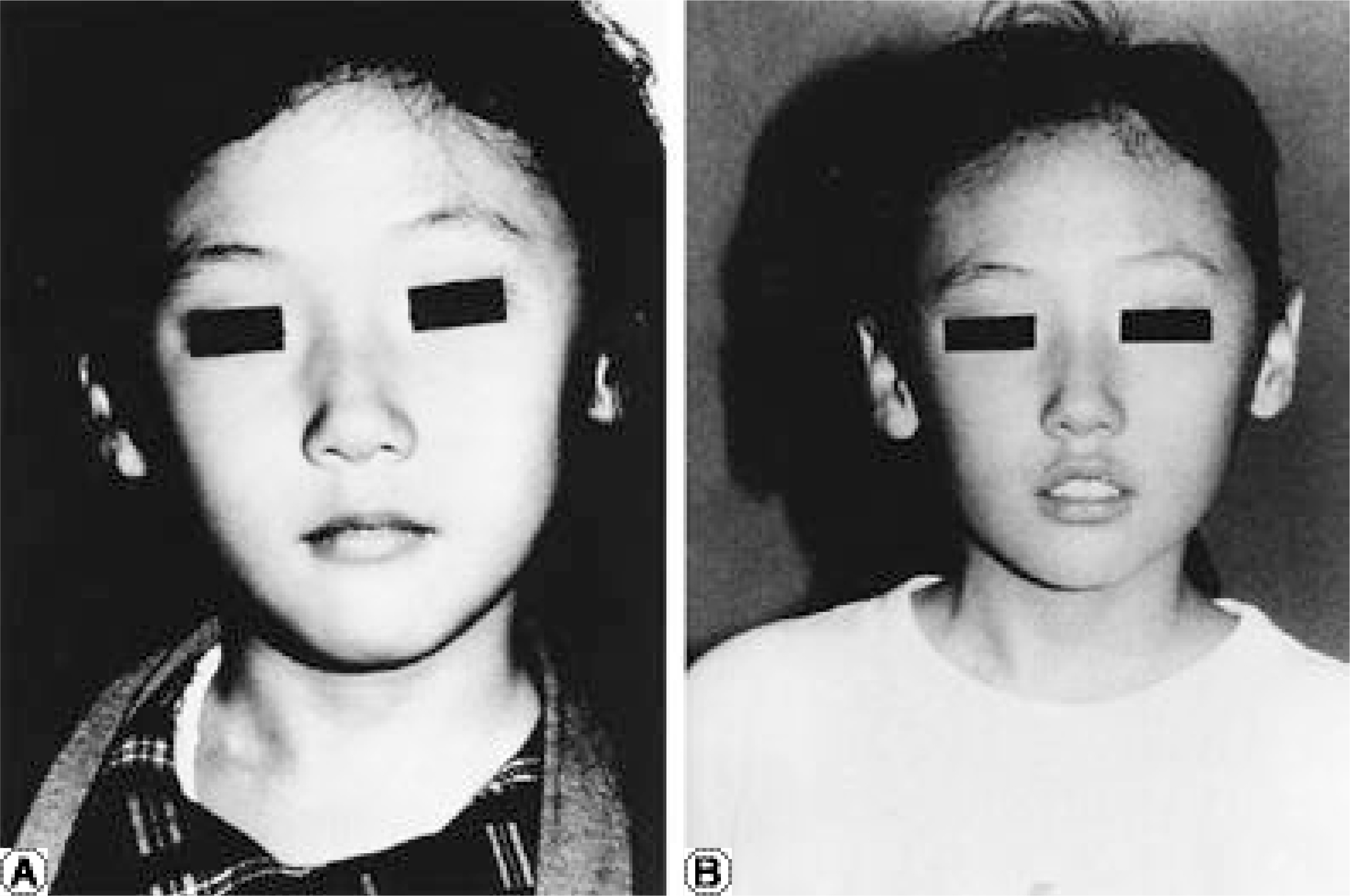J Korean Soc Spine Surg.
2002 Sep;9(3):245-250. 10.4184/jkss.2002.9.3.245.
Partial Resection of the Sternocleidomastoid Muscle for the Congenital Muscular Torticollis
- Affiliations
-
- 1Department of Orthopaedic Surgery, Kang-Nam St. Mary's Hospital, The Catholic University of Korea, College of Medicine, Korea. iyokped@cmc.cuk.ac.kr
- KMID: 2003232
- DOI: http://doi.org/10.4184/jkss.2002.9.3.245
Abstract
-
STUDY DESIGN: This is a retrospective study determining the surgical result of the partial resection of the sternocleidomastoid (SCM) muscle for the congenital muscular torticollis.
OBJECTIVES
To evaluate the efficacy of the partial resection of the sternocleidomastoid muscle for the correction of the congenital muscular torticollis.
MATERIALS AND METHODS
We reviewed 19 patients who were treated by the partial resection of the sternocleidomastoid muscle from 1990 to 1997. The mean age at the time of the operation was 8 year 3 months. Each patient was examined the range of the motion of the neck for the functional results by the modified Ling's criteria, and the tilt of the head, facial asymmetry, presence of the lateral band, loss of the sternomastoid column and quality of the scar for the cosmetic results by the modified Ling's criteria. The over-all cosmetic and functional results were analyzed by the criteria similar to those described by Canale et al.
RESULTS
Functionally, 5 patients (26.3%) were excellent, 10 (52.6%) good, 2 (10.5%) fair, and 2 (10.5%) poor. Cosmetically, 7 patients (30.8%) were excellent, 9 (47.4%) good, 1 (5.3%) fair, and 2 (10.5%) poor. The complication was one lymphatic leakage. Seven of 8 patients were good and one patient was fair under the age of 5. Six of 7 patients were good and one patient was poor between the age of 6 and 10. Two of 4 patients were good and two patients were poor over the age of 11.
CONCLUSION
The partial resection of sternocleidomastoid muscle for the congenital muscular torticollis would be recommendable, because it is a simple, safe procedure and usually produces satisfactory results. All partial rescetion of the sternal and clavicular head of the sternocleidomastoid muscle may prevent the unsatisfactory cosmetic result which is lateral band due to the clavicular head of the sternocleidomastoid muscle. The good results were achieved in case of under the age 10 years.
Figure
Reference
-
1). Akazawa H, Nakatsuka Y, Miyake Y, Takahashi Y. Congenital muscular torticollis. Longterm followup of thirty-eight partial resections of the sternocleidomastoid muscle. Arch Orthop Trauma Surg. 112:205–209. 1993.
Article2). Canale ST, Griffin DW, Hubbard CN. Congenital muscular torticollis. A longterm followup. J Bone Joint Surg. 64A:810–816. 1982.
Article3). Cheng JC, Au AW. Infantile torticollis: a review of 624 cases. J Pediatr Orthop. 14(6):802–808. 1994.4). Chung CY, Choi IH, Lee DY, Cho TJ, Lee PS. Congenital muscular torticollis. Comparative analysis between unipolar and bipolar release of the sternocleidomastoid muscle. J Korean Orthop Assoc. 31:1054–1060. 1996.5). Fekel RD, Westin GW, Dawson EG, Oppenheim WL. Muscular torticollis. A modified surgical approach. J Bone Joint Surg. 65A:894–900. 1983.6). Fernando DB, Steven RC. Endoscopic surgical treatment for congenital muscular torticollis. Plast Reconstr Surg. 101:20–24. 1998.7). Ippolito E, Tudisco C, Massobrio M. Longterm results of open sternocleidomastoid tenotomy for idiopathic muscular torticollis. J Bone Joint Surg. 67A:30–38. 1985.
Article8). Ling CM. The influence of age on the results of open sternomastoid tenotomy in muscular torticollis. Clin Orthop. 116:142–148. 1976.
Article9). Minamitani K, Inoue A, Okuno T. Results of surgical treatment of muscular torticollis for patients > 6 years of age. J Pediatr Orthop. 10:754–759. 1990.10). Staheli LT. Muscular torticollis. Late results of operative treatment. Surgery. 69:469–473. 1971.11). Tse P, Cheng J, Chow Y, Leung PC. Surgery for neglected congenital torticollis. Acta Orthop Scand. 58:270–272. 1987.
Article12). Wirth CJ, Hagena FW, Wuelker N, Siebert WE. Biterminal tenotomy for the treatment of congenital muscular torticollis. J Bone Joint Surg. 74-A:427–434. 1992.
- Full Text Links
- Actions
-
Cited
- CITED
-
- Close
- Share
- Similar articles
-
- Two Cases of Sternomastoid Tumor
- Congenital Torticollis with Bilateral Sternocleidomastoid Muscle Contracture
- Solitary Osteochondroma of the Clavicle associated with Congenital Muscular Torticollis: A Case Report
- Ultrasonographic Measurement of the Sternocleidomastoid Muscle in Congenital Muscular Torticollis
- Familial Congenital Muscular Torticollis: A Case Report



